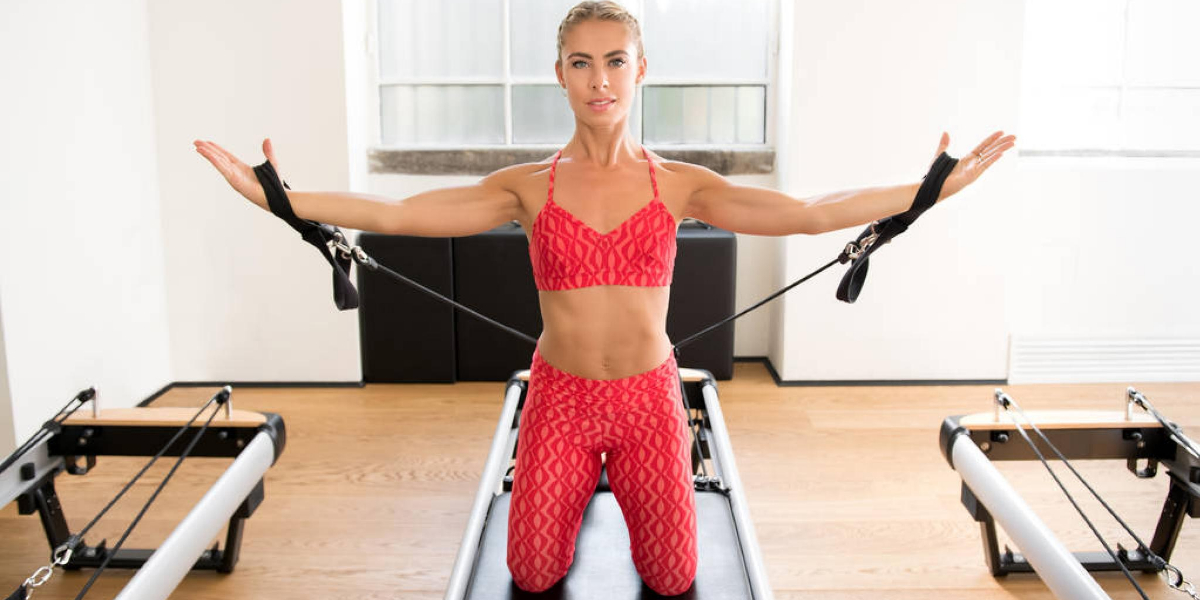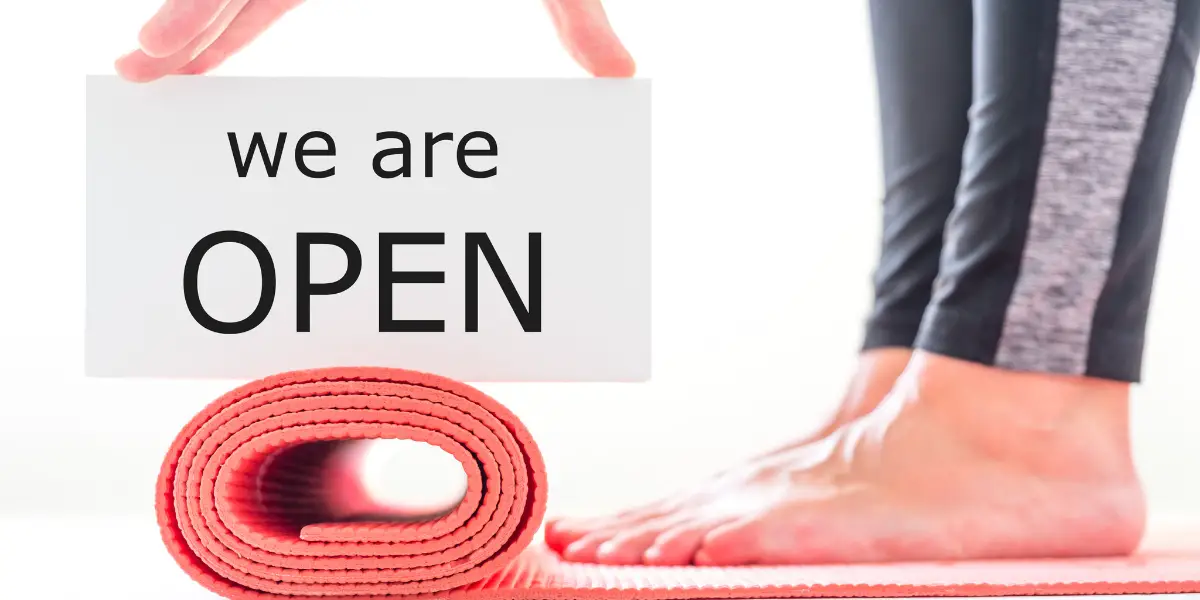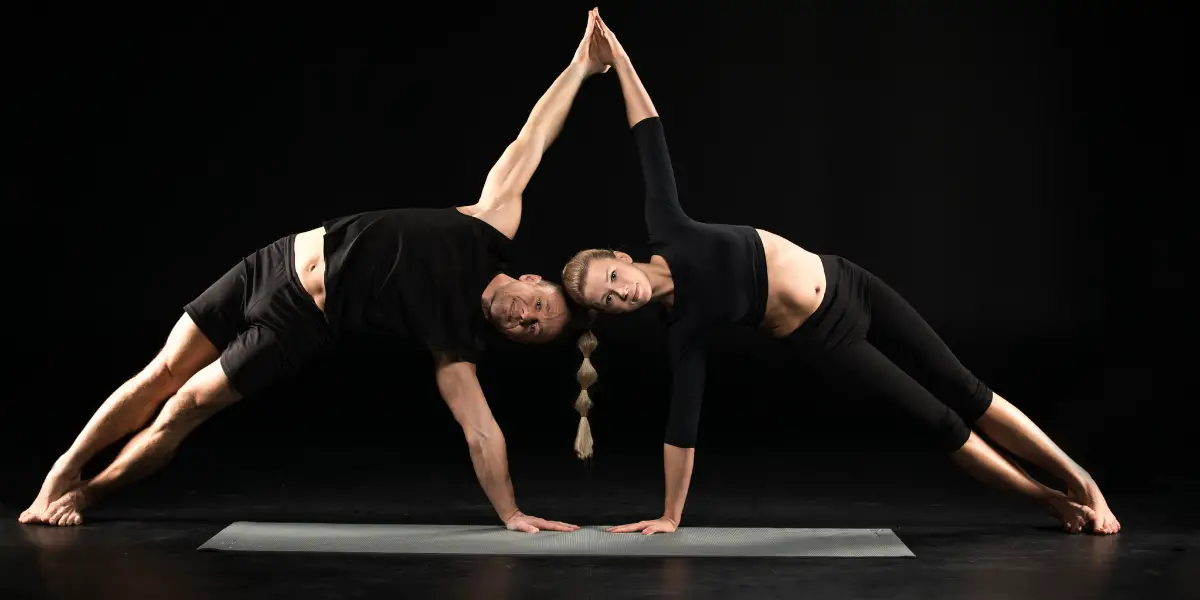People are usually intrigued by my Pilates Reformer. They will ask: “what does it do?”, “how does it work?”, “will I get a good workout?”, but that isn’t the most common question.
The most common question I get asked is “Is the reformer an instrument of torture?!” thanks to its bed like shape with springs, straps and moving parts.
Depending on the workout I’ve put a client through the answer could be yes or no!
Joking aside, the Pilates reformer is a truly unique, versatile, cleverly designed piece of equipment. It is unlike any other piece of equipment you will find in a gym environment. It is expensive to buy and extremely durable, but is it worth the investment?
In this guide I will answer this and many more questions. So read on to find out everything you need to know about a Pilates Reformer.
How was the Pilates Reformer invented?
Let’s begin with where the idea behind its creation came from. Joseph Pilates, the creator of Pilates, was inspired to create the Reformer after helping to rehab WWll patients in hospital.
He attached adjustable springs and pulleys to hospital beds to support and encourage soldiers to move as they recovered from injury.
He found that patients could begin to strengthen their muscles even when bed-bound. Traditional Pilates uses body weight to improve core strength and muscle tone, however that wasn’t possible with soldiers recovering in beds. By creating a set of Pilates reformer exercises the patients could do in bed, he gave them a way to exercise using spring tension rather than body weight.
Hence, the idea of a bed-like frame, aka the carriage, you can lie on when using the reformer and the springs and straps.
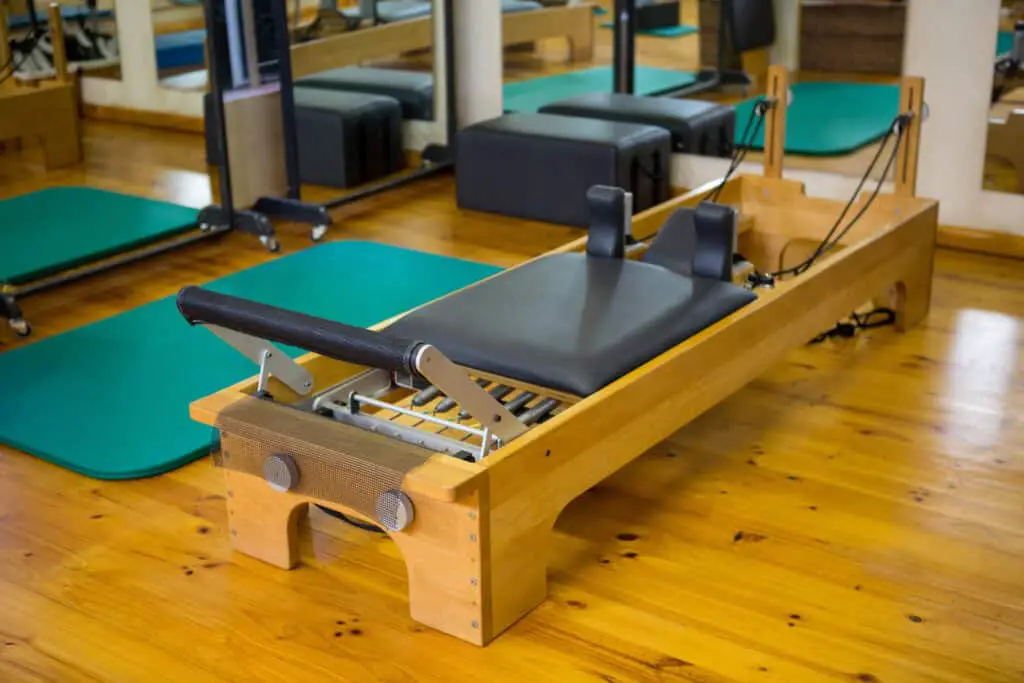
Today many physiotherapists use reformers when rehabilitating patients and to help to prevent recurring injuries.
Many professional athletes, Olympians, international tennis stars, and professional footballers are featured in the press using this amazing piece of equipment as part of their weekly training regime, as part of their own unique rehab journeys and as a way to target specific muscle groups.
But is the Pilates Reformer only beneficial to athletes and professional sports people or those needing rehabilitation from injury?
Who should use a Reformer?
Although it was originally developed to aid recovery, these days it’s become more widely used by those looking to reap the benefits.
Anyone can use a Pilates reformer, however you should seek personal training if you’ve never used one before to reduce the risk of injury.
Modern reformers share a lot in common with the original design. They are still bed shaped and use a variety of springs to add resistance to workouts.
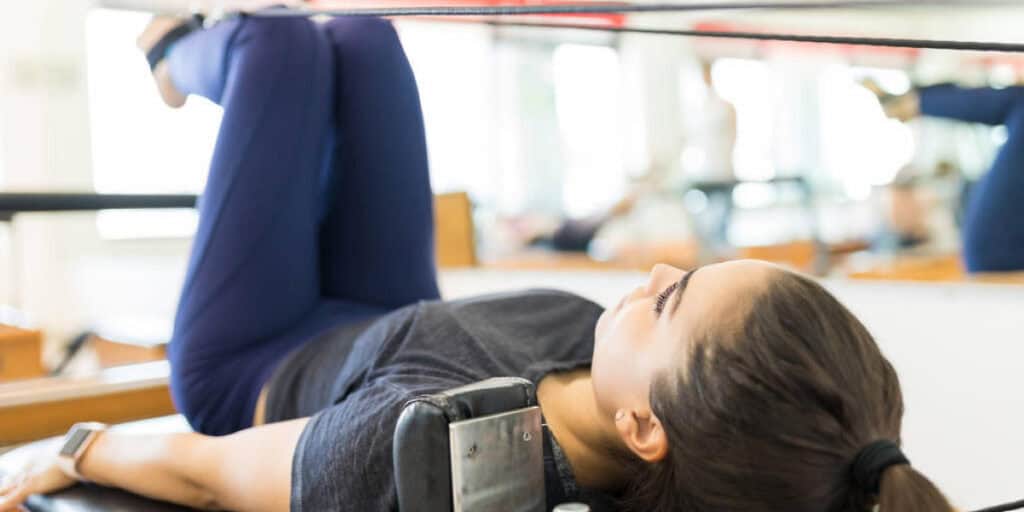
You do not have to have experienced ‘Mat Pilates’ in order to use a Reformer, although I would recommend learning the fundamentals of control, alignment and breathing.
I recently introduced the reformer to my 82-year-old dad. He has never done Pilates. He was amazed by its versatility and the fact he could exercise whilst lying down and yet still ‘feel’ a deep connection with so many muscles throughout his entire body. Using his words and coming from an engineering background, it is such a “clever piece of kit.” Trust me, that’s very high praise!
If you’re thinking of buying on I recommend checking local Pilates studios to see if they offer reformer classes so that you can try before you buy. They’re a costly investment, Pilates reformer classes will not only help you decide if you want your own, they’ll also give you the training required to feel confident about using one at home.
Do you lie down to do reformer exercises?
As the original design was based on a bed, this is an understandable question. Modern Pilates reformer workouts incorporate laying, kneeling and standing exercises.
In some cases you even stand on the floor when using this equipment, it’s very versatile! You might kneel on the carriage or lie down on your back or front. If you have an issue with your balance, then being able to sit or lie down whilst using this equipment has its obvious advantages.
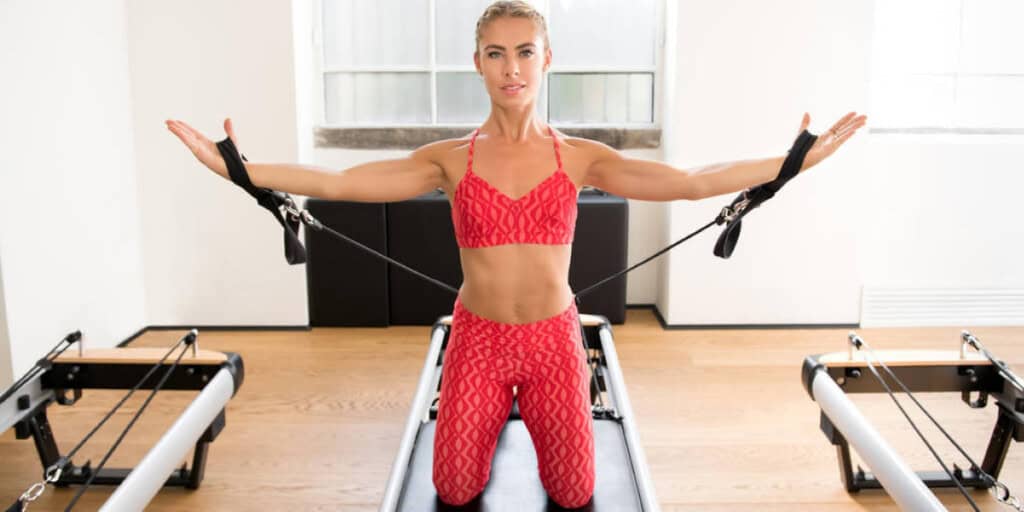
When using the Reformer you are encouraging movement, building strength, increasing awareness of how your body moves and feels.
Assuming you are being taught whilst using the reformer, then expect to be in a supine position (lying horizontally face up) for at least part of your session.
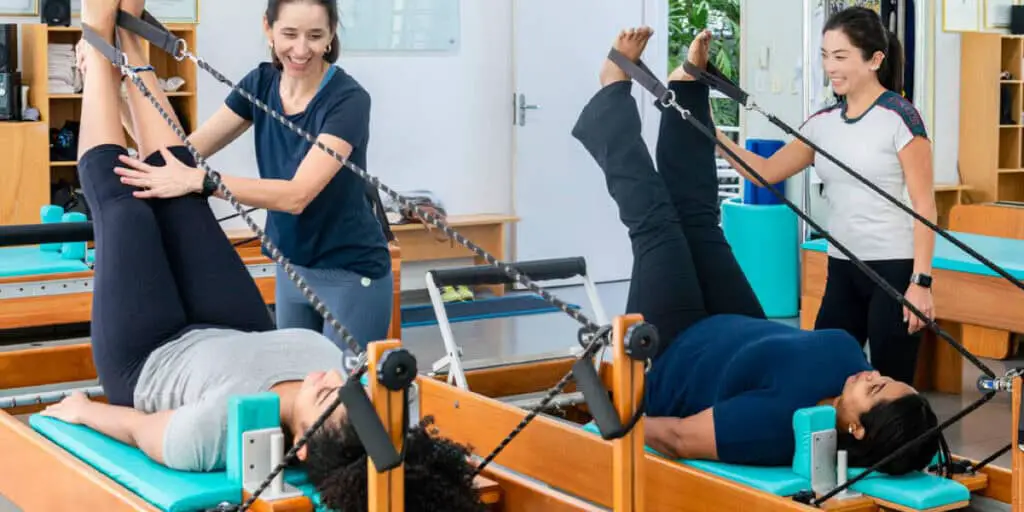
The versatility of the reformer will be highlighted when you work with a Qualified Creative Instructor who can embrace the classic Reformer exercises and add their own imaginative twists to keep you challenged, enthused and progressing.
I love how many clients marvel at just how many exercises you can do on the reformer, and they are amazed at my ability to remember them all!
Benefits of a Pilates Reformer
If you want to build strength in your upper body, your core, glutes and/or legs, then using a Reformer will certainly help you achieve these goals. They are great for stretching, toning, and strengthening the abdominals. This exercise helps improve posture and balance, but it will do so much more:
- Improves your coordination by challenging your mind-body connection;
- Improves your mobility and range of movement;
- Strengthen core muscles which are essential for maintaining proper posture and balance;
Using the straps your movement can be challenged and supported, so you feel more connected and able to do more than you would without that support.
The movements you make on the Reformer will then translate into your everyday life as you move with more agility, strength, confidence and awareness.
I often remind clients during our mat Pilates class that our bodies are not symmetrical, we all tend to have a stronger side, misalignments.
When I’m teaching clients on the Reformer it’s a wonderful tool for making these misalignments noticeable, and then we can address them.
Should I get a reformer?
My reformer is the most expensive piece of Pilates equipment I own. It was a big investment for my Pilates studio, but as a Pilates teacher it was a worthwhile investment.
If you have the space, the money and the passion for Pilates, a Pilates reformer is an excellent investment. However, for most people, visiting a gym or studio to use their equipment is likely to be the better option.
I use the reformer daily with clients, and dedicated classes can command a premium price, so in the long term it will pay for itself.
Would it be worthwhile for someone who isn’t training clients and who isn’t trained to use a Reformer making such an investment?
Firstly and importantly, these are pieces of equipment that hold their value. You can buy them second hand but will rarely find one that is considerably cheaper than the market value as they are built to last and withstand a lot of use.
Unlike some gym equipment they are not computerised and therefore don’t date. They don’t require software updates and there are no electronics to go wrong.
The general design of the Reformer is the same regardless of which manufacturer you buy from. However, the more expensive ones do seem to be more sturdy, you are investing in a quality piece of long-lasting equipment.
What’s the best Pilates Reformer?
After spending a lot of time researching different makes and models, I came to the conclusion that the more money you invest, the better quality.
The Allegro 2 Body Balance Reformer provides exceptional build quality, as a Pilates Instructor I’d recommend this to anyone looking to purchase a reformer.
During my research, I came to the conclusion that it is best to buy from well-known manufacturers such as Align-Pilates, Body Balance, Stott Pilates.
Some Reformers are lower to the ground than others, which can be an issue for someone with limited mobility due to age, injury or other limitations.
One of the reasons I chose the Allegro 2 is that it has the option of adding legs which raises it higher from the ground. This extra height also adds fun and challenge for some movements as you are further away from the floor when standing or kneeling on the carriage, challenging balance and coordination.
Things to consider when buying a Pilates Reformer
As mentioned above, a reformer is an expensive investment, but that’s not the only consideration.
Space
How much space do you have to store your Reformer? If you are planning on your reformer living in your home permanently, then you can go for one of the sturdy, heavier options, being aware that they are heavy and not easy to manoeuvre.
If you need something that is more portable that you will need to store away in between each use, then there are a few lightweight foldable options on the market.
This isn’t something you’ll use all the time so you need to be prepared to sacrifice space to store it when not in use.
Accessories
When buying your reformer, there are numerous accessories you can purchase to enhance your use of this fabulous machine, such as a box, jump board or platform extender.
Of course these will add extra costs, fortunately they don’t need to be purchased at the same time and can be picked up at a later date once you are confidently utilising your reformer.
Additional accessories are a great way to add more variety and challenge, but of course they’ll also need additional storage space when not in use.
Lessons
If you plan on having your Reformer at home, I 100% recommend having a number of lessons with a qualified Reformer Instructor, regardless of fitness levels, before making an investment.
Using a studio reformer and being correctly trained not only helps you get the most out of your new investment, it will also help you prevent injury via misuse.
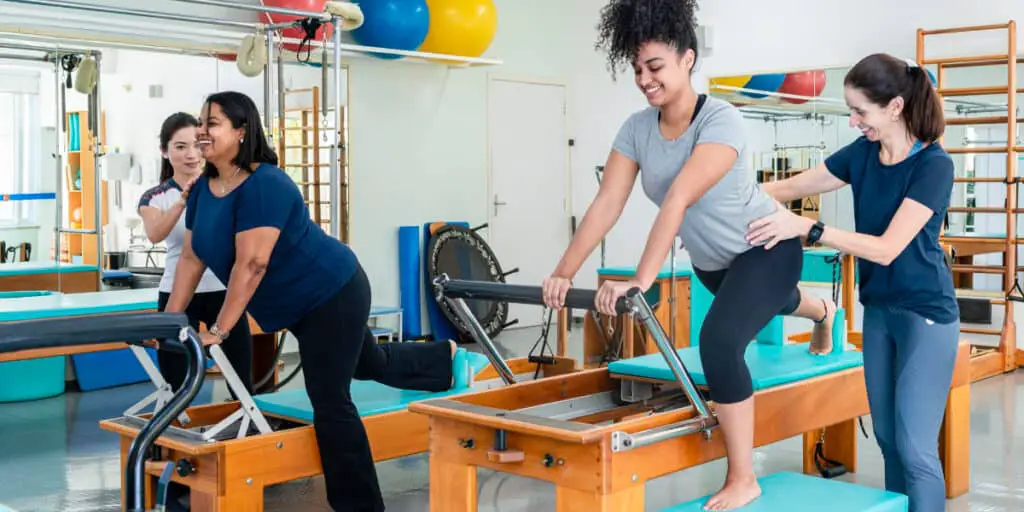
I would also suggest continuing with at least monthly sessions with a qualified instructor, not only can they demonstrate a variety of exercises, to keep your own home workout inspired, they will ensure you haven’t picked up any bad habits and are using the equipment safely.
Whether this investment is worth it will come down to how regularly you use it and whether it is just for your own personal use or to use with clients. I would definitely recommend buying from a well known
Is Pilates reformer a good workout for you?
Working out on the Reformer is fun especially under professional guidance. It will also be very different to anything you’ve ever done before, so is it a good workout?
Yes, the Pilates Reformer is a great workout for anyone who wants to get in shape. The reformer provides a full range of motion, allowing you to work out every muscle group. This machine also helps build strength and endurance.
It is a unique experience that can be as challenging or as relaxing as you wish. I personally love that I can use the Reformer to help clients to :
- Build Strength
- Increase Flexibility
- Improve Range of Movement
- Challenge coordination
- Build stamina and endurance
- Improve balance
When you finish a session, expect to experience some Delayed-Onset Muscle Soreness (aks DOMS, see: Soreness after Pilates: What’s normal and what isn’t?).
Muscle soreness in training is quite common, especially when you start training differently. The use of the springs on the reformer enables you to subtly strengthen the whole body, not just targeting the larger muscle system but firing up and activating those smaller stabilising muscles.
I encourage clients to work on unilateral movements to counterbalance an uneven weakness and correct imbalance.
I have talked lots about the physical benefits, but for many, myself included, there is a positive impact on mental well-being.
Mindfulness in movement that focuses on your body, being in the moment as you move, and concentrating on breathing can really help calm the mind and relax the body.
Reformer Pilates can increase endorphins, those fabulous feel good happy chemicals, whilst reducing cortisol, the hormone relating to stress.
Many clients arrive before a reformer session feeling stressed and overwhelmed by life, but leave feeling calmer and stronger in mind and body.
What results can you expect to see?
Your body shape will change. Using the springs and straps on the reformer to add resistance will create lean, toned muscles.
It is a low-impact workout and the repetitive movements tone the body, building strength and endurance.
Load can be added to the springs to increase challenge or support movement dependent on the goal of the exercise and your level of fitness.
As you increase your muscle mass, you boost your resting metabolic rate. Your muscles use a lot more energy than fat when resting, so theoretically if you build strength & gain more muscle mass but don’t increase your calorie intake you can potentially lose weight using the reformer.
Is reformer Pilates enough exercise?
Would I recommend only doing Reformer Pilates over any other form of exercise?
Yes, Reformer Pilates can be enough exercise as it gives you a whole-body workout. However, you will benefit by combining it with other exercises such as running or swimming.
If you only have time to exercise once or twice a week, then using the reformer will give you that whole-body experience as well as mental health benefits. It’s very unlikely you will get injured using the reformer and can use it when rehabbing from injury.
You can raise your heart rate and improve your cardio fitness, but what I would say is that life is all about variety and whilst a reformer session is going to tick lots of boxes, I think adding in time outdoors in nature to walk, run, swim would also be beneficially and compliment your reformer workouts.
Final thoughts
If you’ve never tried Reformer Pilates my question is…what are you waiting for?
If you want to try something new and challenging, there are numerous classes available and teachers who offer 1-2-1 and duet sessions.
It is hard to explain just how adaptable, unique and versatile the Reformer is, I love it, my clients love it, enough said!
The cost of owning a Pilates Reformer should never dictate whether you should invest in one. If you’re happy with your current set up, then by all means continue. But if you’re looking for an investment piece of equipment to complement your home gym, then the Reformer is a great choice.
I hope this has been helpful.
Sources
https://principlepilates.com/sports-legends-rocking-the-reformer

